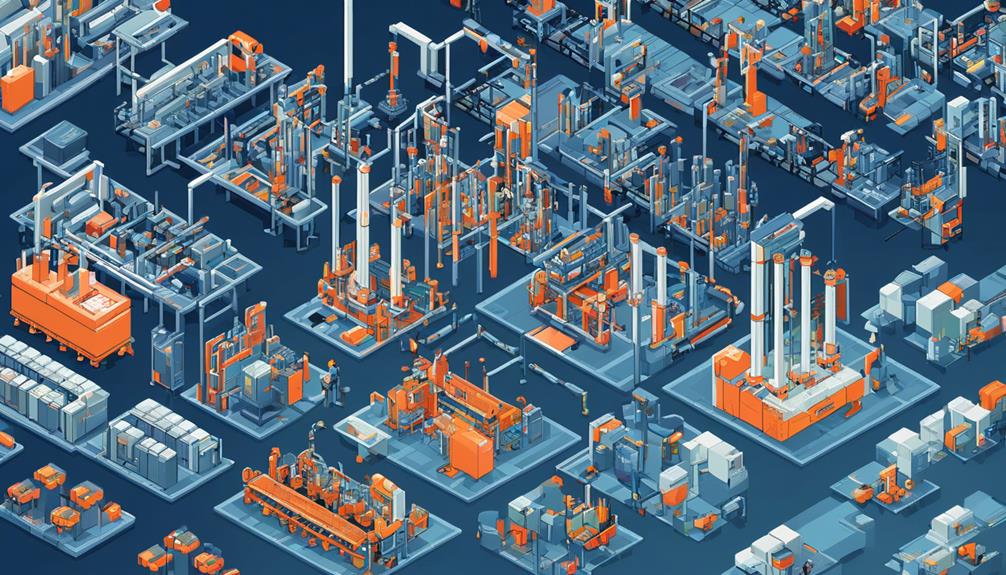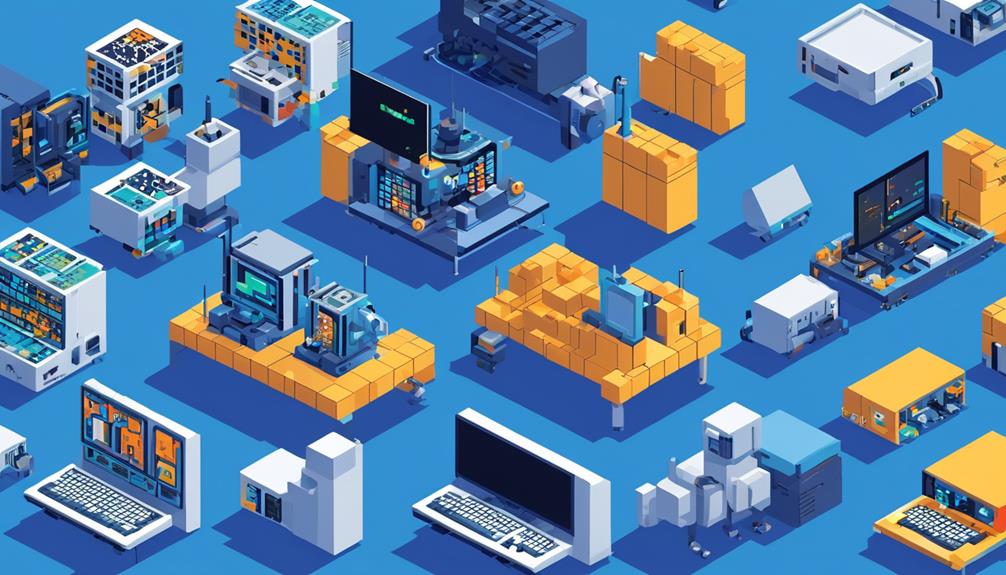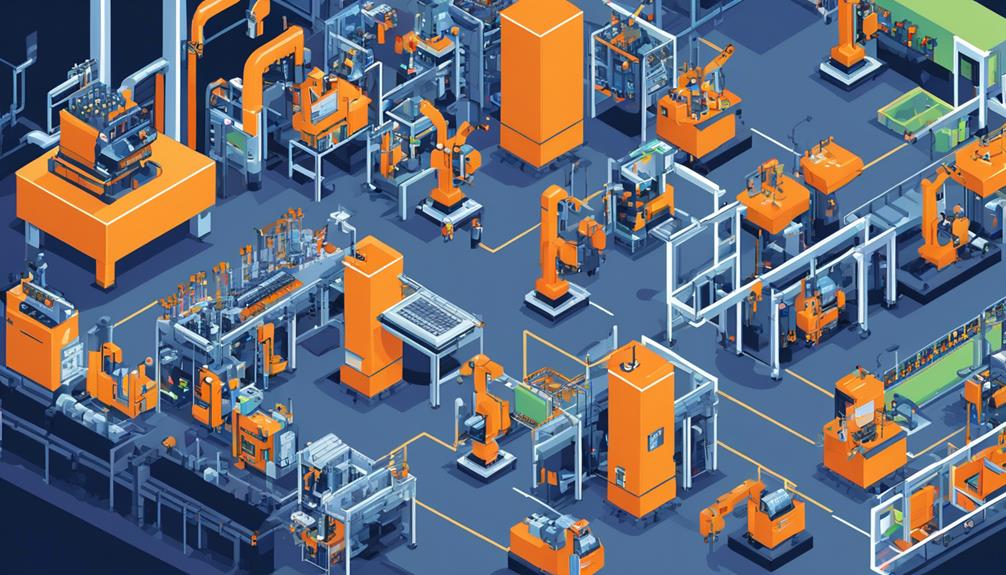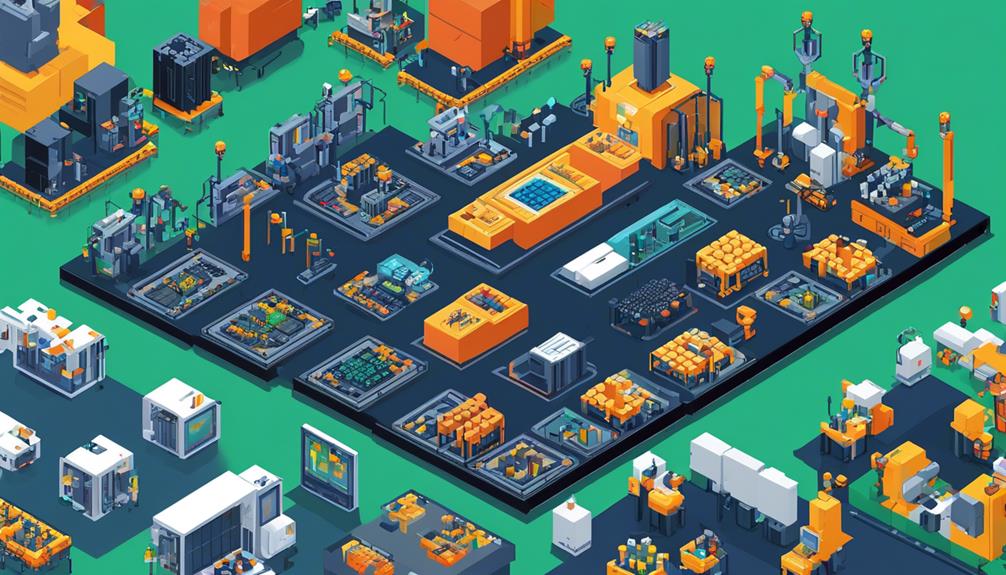In the realm of smart manufacturing, the utilization of edge computing hardware has become increasingly crucial. These devices play a pivotal role in enabling real-time data processing and analysis at the edge of the network, offering a range of benefits for the manufacturing industry.
By reducing latency, improving data quality, and minimizing the amount of data sent to the cloud, edge computing not only enhances efficiency but also ensures the protection of industrial infrastructure and data through its built-in cybersecurity features.
However, the potential impact of edge computing on the manufacturing industry extends far beyond these advantages.
So, what does the future hold for edge computing hardware in smart manufacturing?
Key Takeaways
- Edge computing hardware plays a crucial role in real-time data processing and analysis in smart manufacturing.
- It offers increased operational efficiency through real-time data analysis at the edge, ensuring uninterrupted production processes even without a cloud connection.
- Edge computing enhances security measures by processing sensitive data locally, reducing reliance on cloud data processing and improving data privacy and security.
- It provides cost savings through reduced bandwidth and storage costs, as well as scalability and flexibility to accommodate the growing number of IoT devices.
Edge Computing Hardware Overview

Edge computing hardware refers to the devices and components specifically designed to enable efficient and secure processing, analysis, and control of data at the network's edge in industrial edge computing architectures.
In the context of smart manufacturing, edge computing devices play a crucial role in enabling real-time data processing and analysis at the edge of the network, closer to where the data is generated.
Industrial edge computing architectures require robust and reliable hardware solutions to handle the demanding requirements of data processing in manufacturing environments. These hardware devices are designed to withstand harsh industrial conditions such as temperature variations, vibrations, and electromagnetic interference. They are equipped with powerful processors, high-speed memory, and advanced networking capabilities to ensure efficient data processing and communication.
The edge computing hardware used in smart manufacturing includes a wide range of devices such as industrial gateways, edge servers, and industrial PCs. These devices are equipped with specialized software and firmware that enable them to securely collect, process, and analyze data in real-time. They provide the necessary computational power to run complex algorithms and machine learning models at the edge, enabling intelligent decision-making and automation.
Furthermore, edge computing hardware in smart manufacturing also incorporates cybersecurity features to protect against unauthorized access and data breaches. These devices implement secure communication protocols, encryption techniques, and access control mechanisms to ensure the integrity and confidentiality of the data.
Benefits of Edge Computing in Manufacturing
Edge computing offers several benefits for the manufacturing industry.
Firstly, it enables increased operational efficiency by allowing real-time data analysis at the edge, reducing the need for data to be transmitted to the cloud and enabling faster decision-making.
Additionally, edge computing enhances security measures by processing sensitive data locally, minimizing the risk of data breaches and ensuring compliance with privacy regulations.
These advantages make edge computing a valuable solution for manufacturers looking to improve their processes and protect their data.
Increased Operational Efficiency
Implementing edge computing in the manufacturing industry leads to a significant improvement in operational efficiency. Industrial edge computing capabilities enable real-time data processing, reducing latency and enabling faster response times. This allows for quicker decision-making, enhancing the overall productivity of the manufacturing sector.
Moreover, edge computing ensures uninterrupted production processes even if the connection to the cloud is lost, improving reliability and minimizing downtime. By processing data at the edge, edge computing reduces bandwidth and storage costs, resulting in cost savings for manufacturers.
Additionally, edge computing enhances data privacy and security by allowing sensitive data to be processed and stored locally, reducing the risk of data breaches. The scalability and flexibility of edge computing architectures accommodate the growing number of IoT devices and sensors in smart manufacturing environments, further optimizing operational efficiency.
Real-time Data Analysis
Real-time data analysis in the manufacturing industry is a crucial aspect of edge computing, enabling immediate decision-making and precise control over industrial processes. With the increasing prevalence of IoT devices and sensors in smart manufacturing environments, edge computing provides the necessary computing resources to process and analyze data locally at the edge.
This reduces latency and improves response times, as data can be processed in real-time without the need for round-trip communication with the cloud. Additionally, edge computing reduces the amount of data that needs to be sent to the cloud, resulting in cost savings and optimized bandwidth usage.
Furthermore, edge computing enhances data privacy and security by allowing sensitive data to be processed and stored locally, minimizing the risk of unauthorized access.
Enhanced Security Measures
With the growing importance of data security in smart manufacturing environments, edge computing presents enhanced security measures that protect sensitive data and operations from unauthorized access and breaches. Edge computing platforms offer built-in security features, such as secure communication protocols (e.g., MQTT and TLS), that ensure data integrity and privacy. These platforms also enable local data processing, reducing reliance on cloud data processing and minimizing the amount of data sent over the network, thus improving data security. By eliminating the need for open inbound firewall ports, edge computing reduces the attack surface and vulnerability of industrial environments. Additionally, edge computing employs a broker-based architecture for centralized control and secure access to industrial data, enhancing cybersecurity measures. The table below summarizes the benefits of edge computing in terms of data security in smart manufacturing.
| Enhanced Security Measures |
|---|
| Built-in security features |
| Local data processing |
| Secure communication protocols |
| Reduced vulnerability |
| Unified data management |
Real-Time Data Processing With Edge Computing
Edge computing enables efficient and secure processing of data at the network's edge, improving data quality and reducing reliance on cloud-based infrastructure. In the context of smart manufacturing, real-time data processing is a crucial aspect that allows industries to make faster and more informed decisions.
Here are some key points about real-time data processing with edge computing:
- Reduced latency: Edge computing brings processing power closer to the data source, minimizing the latency associated with sending data to the cloud and waiting for a response. This near-instantaneous data processing enables timely actions and reduces delays in critical manufacturing processes.
- Local autonomy: With edge computing, industrial environments can have granular oversight and control over data processing and analysis. By keeping the data processing local, manufacturers can ensure that their operations continue even in situations where the cloud connection is disrupted.
- Scalability: Edge computing architectures can easily scale to accommodate growing data volumes and operational requirements. The distributed nature of edge devices allows for the seamless addition of new devices to the network, making it possible to handle large amounts of real-time data generated by sensors and machines in smart manufacturing settings.
- Democratization of data: Real-time data processing at the edge makes operational technology (OT) data accessible to stakeholders across the organization. By providing timely and accurate insights, edge computing enables decision-makers at various levels to access and leverage real-time data, enhancing operational efficiency and driving innovation.
Role of AI and ML in Edge Computing Hardware

In the realm of smart manufacturing, the integration of AI and ML algorithms into edge computing hardware empowers industrial systems to learn from data and make intelligent decisions, revolutionizing the way data is processed and utilized. AI and ML algorithms have become critical components of edge computing, enabling real-time data processing and analysis at the edge of the network, closer to where data is generated.
Edge computing, in combination with AI and ML, addresses the limitations of traditional cloud-based architectures in smart manufacturing. By leveraging edge computing, AI and ML algorithms can be deployed directly on IoT devices and operational technology (OT) systems, allowing for faster processing and analysis of data. This enables industrial systems to derive actionable insights and optimize processes based on real-time data, improving efficiency and productivity.
One key advantage of AI and ML in edge computing hardware is the ability to perform real-time analytics and decision-making without relying on cloud connectivity. This is particularly beneficial in smart manufacturing environments where low latency and high reliability are essential. By processing data locally on edge devices, AI and ML algorithms can quickly respond to changing conditions and make time-sensitive decisions.
Furthermore, edge and cloud computing technologies work together to enhance the accessibility and scalability of AI and ML algorithms in smart manufacturing. Edge devices act as a buffer between the cloud and the physical world, allowing for localized data processing and reducing the amount of data that needs to be transmitted to the cloud. This multi-layered approach to data processing enhances security, reduces bandwidth requirements, and enables scalability for increasing workloads.
Importance of Cybersecurity in Edge Computing
The significance of ensuring robust cybersecurity measures in edge computing cannot be overstated as it is vital for protecting industrial infrastructure, data, and operations from unauthorized access and data breaches. In the context of smart manufacturing, where edge computing plays a crucial role in processing data from IoT devices at the network's edge, cybersecurity becomes even more critical.
To paint a vivid picture of the importance of cybersecurity in edge computing, consider the following:
- Protection against unauthorized access: Edge computing allows data processing and analysis to occur closer to where it is generated, reducing latency and enhancing efficiency. However, this also means that edge devices are more vulnerable to unauthorized access. Robust cybersecurity measures, such as authentication and access control mechanisms, are necessary to prevent unauthorized individuals or malicious actors from gaining access to sensitive industrial data.
- Safeguarding against data breaches: Edge computing involves the collection and processing of vast amounts of sensitive data. Without proper cybersecurity measures in place, this data is at risk of being compromised, leading to significant financial and reputational damage. Implementing encryption protocols, data integrity checks, and secure data storage mechanisms are essential to prevent data breaches in edge computing environments.
In the realm of smart manufacturing, where the cloud and edge computing work in tandem, cybersecurity measures must be implemented at both layers. This ensures the security of industrial automation and control systems by protecting them from cyber threats and vulnerabilities.
Leveraging Ethernet Communications in Smart Manufacturing

Ethernet communications play a pivotal role in enabling standardized, reliable, and secure data transfer between industrial devices and systems in the realm of smart manufacturing. In today's industry, where processing large volumes of data in real-time is crucial, leveraging Ethernet communications is essential for establishing seamless connectivity and interoperability across different devices and platforms.
One of the key benefits of Ethernet communications in smart manufacturing is the support for local data processing. By enabling data transfers within the local network, latency is significantly reduced, allowing for faster and more efficient industrial operations. This is particularly important in scenarios where real-time decision-making and analytics are required.
Another advantage of Ethernet communications is its ability to support the efficient and scalable transfer of large volumes of data. With the proliferation of IoT devices and the increasing amount of data generated in smart manufacturing environments, Ethernet provides the necessary bandwidth and reliability to handle the data flow effectively.
Moreover, Ethernet communications enable the establishment of secure and standardized data transfer protocols. This ensures that data is transferred securely between devices and systems, safeguarding critical information and preventing unauthorized access. Standardization further enhances interoperability between different devices and systems, enabling seamless integration and collaboration in the smart manufacturing ecosystem.
Challenges for Automation Engineers in Implementing Edge Computing Hardware
Implementing edge computing hardware in smart manufacturing presents numerous challenges for automation engineers. These challenges include:
- Integration complexity: Integrating diverse devices and sensors into the automation infrastructure adds complexity. Automation engineers must ensure seamless communication among these devices and sensors to enable real-time data exchange and decision-making.
- Network connectivity: Reliable and low-latency connectivity is crucial for edge devices in smart manufacturing. Automation engineers need to design and maintain a robust network infrastructure that can handle the high volume of data generated at the edge. They must also address potential connectivity issues to ensure uninterrupted operations.
- Security considerations: Edge computing introduces new security challenges. Automation engineers must implement robust security measures to protect edge devices from unauthorized access. They must also ensure the integrity and confidentiality of data at the edge, especially considering the sensitive nature of operational data in smart manufacturing. Compliance with privacy regulations is also a key consideration.
- Skillset and workforce requirements: Implementing and managing edge computing systems demands specialized skills and knowledge. Automation engineers need to possess expertise in edge computing technologies, including hardware and software integration, networking, and cybersecurity. Manufacturers may need to invest in training their workforce or collaborate with external experts to bridge any skill gaps.
- Scalability and future-proofing concerns: Smart manufacturing environments continue to grow in complexity, with an increasing number of devices and emerging technologies. Automation engineers must design edge computing infrastructure that can scale to accommodate this growth. They need to consider future requirements and ensure compatibility with evolving technologies to avoid costly upgrades or replacements.
Interoperability Considerations for Edge Computing Systems

When considering interoperability for edge computing systems, three main points come to mind.
Firstly, compatibility with devices is crucial to ensure seamless integration and communication between edge devices and cloud applications.
Secondly, data integration challenges arise due to the need to aggregate and process data from various sources in a standardized format.
Lastly, standardization efforts play a vital role in establishing common protocols and frameworks that enable interoperability between different edge computing systems.
Compatibility With Devices
Ensuring seamless communication and data exchange among various devices and platforms is a critical consideration for achieving compatibility with a range of devices in edge computing systems for smart manufacturing.
Interoperability is key to integrating edge computing systems with diverse industrial devices, including sensors, actuators, and control systems. To achieve compatibility, edge computing systems must support different communication protocols and standards, enabling smooth data flow and control across heterogeneous devices and systems.
Additionally, compatibility with legacy systems and new IoT devices is essential for integrating edge computing systems with existing manufacturing infrastructure. This compatibility allows for efficient data storage and processing, leveraging the computing power of edge devices while seamlessly integrating with cloud computing resources.
Data Integration Challenges
To address the interoperability challenges in edge computing systems, seamless data integration at the edge requires overcoming compatibility issues between diverse devices and systems. The manufacturing industry, in particular, faces significant data integration challenges due to the volume of data generated by sensors, machines, and other devices in smart manufacturing environments. This data needs to be aggregated, transformed, and synchronized to enable real-time analytics and decision-making. However, the diversity of edge devices and protocols complicates the integration process. Legacy equipment utilizing different communication protocols and data formats further exacerbates the challenge. Resolving these challenges involves ensuring effective communication, data sharing, and cohesive operation among diverse systems. The table below highlights the key data integration challenges in edge computing systems.
| Data Integration Challenges |
|---|
| Compatibility between different data formats, protocols, and standards |
| Complexity in data aggregation, transformation, and synchronization |
| Integration of legacy equipment with different communication protocols and data formats |
| Ensuring effective communication and data sharing among diverse systems |
| Facilitating cohesive operation of integrated systems |
These challenges need to be addressed to enable efficient data processing and analysis for various applications, including predictive maintenance, in the smart manufacturing industry.
Standardization Efforts
Standardization efforts in edge computing systems play a crucial role in ensuring seamless interoperability across devices and platforms. In the context of smart manufacturing, where IoT devices generate large volumes of data, standardization becomes imperative to enable efficient data transmission and processing.
To create a vivid image of the importance of standardization efforts, consider the following sub-lists:
- Interoperability considerations:
- Enable seamless communication and data exchange between edge devices and cloud applications.
- Facilitate real-time data transmission and processing in industrial automation systems using common standardization formats like MQTT and Sparkplug B.
- Benefits of standardization efforts:
- Reduce integration complexities and enhance the scalability of edge computing solutions.
- Improve overall efficiency and effectiveness in smart manufacturing by allowing edge computing systems to work together seamlessly.
Software-Driven Innovations in Edge Computing for Manufacturing

Software-driven innovations in edge computing for manufacturing have revolutionized the way industrial systems process, analyze, and control data at the network's edge. With the advent of smart manufacturing and the proliferation of IoT devices, the need for real-time response times and efficient data analysis has become paramount. Edge computing, which brings computing and storage capabilities closer to the data source, addresses these requirements by enabling local processing and analysis of data, reducing latency and bandwidth usage.
One of the key software applications that has facilitated this transformation is MQTT (Message Queuing Telemetry Transport) in combination with Sparkplug B. MQTT is a lightweight messaging protocol that enables efficient and reliable communication between edge devices and cloud applications. Sparkplug B, on the other hand, is a software specification that defines a standard MQTT payload format for industrial automation and control systems. Together, these technologies facilitate real-time communication and data exchange, enabling seamless integration between edge devices and cloud-based analytics platforms.
Furthermore, edge computing architectures in manufacturing leverage software-driven innovations to optimize data processing and analysis. Industrial edge devices are equipped with built-in cybersecurity features, ensuring the security and integrity of data at the network's edge. By processing and analyzing data locally, these devices improve data quality and reduce the amount of data that needs to be transmitted to the cloud, resulting in more efficient use of bandwidth and reduced latency.
Software-driven innovations in edge computing also enable industrial systems to leverage artificial intelligence (AI) and machine learning (ML) algorithms. These algorithms empower edge devices to learn from data and make intelligent decisions in real-time, enhancing the overall efficiency and productivity of manufacturing processes.
Moreover, edge computing platforms offer built-in fault tolerance mechanisms to ensure high availability and protect against data loss. These platforms distribute computing and storage resources across multiple edge devices, ensuring uninterrupted operation even in the event of device failures.
Potential Impact of Edge Computing on the Manufacturing Industry
Edge computing has the potential to bring significant efficiency improvements to the manufacturing industry.
By enabling real-time data analytics and enhanced machine automation, edge computing can optimize production processes and reduce downtime.
This technology allows manufacturers to make faster, data-driven decisions, improving overall operational efficiency and productivity.
Efficiency Improvements in Manufacturing
Efficiency improvements in the manufacturing industry can be achieved through the potential impact of edge computing. By leveraging edge computing in smart manufacturing, manufacturers can optimize their operations and enhance productivity.
Here are two key ways in which edge computing can contribute to efficiency improvements:
- Local processing: Edge computing enables the processing and analysis of operational data at the network's edge, closer to the source. This reduces the latency associated with sending data to the cloud for processing. With edge computing, IoT devices can perform real-time data analytics, allowing for immediate insights and faster decision-making.
- Reduced complexity and cost: Edge computing allows for the consolidation of multiple servers and industrial PCs into a single platform. This simplifies the infrastructure, reduces the physical footprint, and lowers costs associated with maintenance and management. By streamlining the technology stack, manufacturers can achieve greater operational efficiency.
Real-Time Data Analytics
How does real-time data analytics revolutionize the manufacturing industry with the potential impact of edge computing?
Edge computing, in conjunction with IoT devices, enables real-time analysis of manufacturing data at the network's edge. This capability provides immediate insights into manufacturing processes, enhancing operational efficiency and productivity.
By processing and analyzing data locally, edge computing reduces reliance on cloud resources, resulting in faster response times and reduced latency. Additionally, edge devices with built-in cybersecurity features enhance data security and control, mitigating potential risks.
Local processing also improves data accuracy and efficiency, minimizing the need to transmit large volumes of data to the cloud. Overall, edge computing's scalable and flexible hardware resources enable real-time data analytics, empowering smart manufacturing and driving innovation in the industry.
Enhanced Machine Automation
Enhanced machine automation in the manufacturing industry is revolutionized by the potential impact of edge computing. With the integration of edge devices and IoT devices, edge computing enables real-time communication and data processing at the network's edge. This has significant implications for machine automation in smart manufacturing environments.
The potential impact of edge computing on enhanced machine automation can be summarized in two key areas:
- Real-time data processing: Edge computing allows for the processing and analysis of data at the edge devices themselves, reducing the need for data transmission to the cloud. This enables faster response times and improved decision-making for machine automation.
- Improved connectivity and control: Edge computing architectures provide reliable and secure communication between edge devices and cloud applications. This allows for seamless integration of machine automation systems and enables enhanced control and monitoring of manufacturing processes.
Iot and Enterprise Connectivity With Edge Computing Hardware
The integration of IoT and enterprise connectivity with edge computing hardware revolutionizes the way data is processed, analyzed, and controlled at the network's edge. This convergence of technologies enables smart manufacturing and industrial IoT devices to communicate in real-time, improving operational efficiency and decision-making.
Edge computing devices, equipped with built-in cybersecurity features, play a crucial role in this ecosystem. They process and analyze data locally, reducing latency and enhancing data quality. By performing data processing at the edge, only relevant and valuable data is forwarded to the cloud, reducing bandwidth requirements and optimizing network performance.
One key technology enabling IoT and enterprise connectivity is the MQTT (Message Queuing Telemetry Transport) protocol, combined with the Sparkplug B specification. MQTT provides a lightweight, publish-subscribe messaging protocol that facilitates communication between edge devices and cloud applications. Sparkplug B, on the other hand, defines the payload format and topic structure for industrial IoT and automation applications, ensuring interoperability and standardization.
The cloud, with its scalable computing resources, plays a vital role in storing, analyzing, and visualizing the vast amounts of industrial data generated by IoT devices. Cloud applications enable real-time monitoring, predictive maintenance, and data-driven decision-making.
To ensure the security and integrity of industrial infrastructure, data, and operations, robust cybersecurity measures are implemented. Edge computing devices are equipped with features such as secure boot, secure firmware updates, and encryption. Additionally, access controls, firewalls, and intrusion detection systems are implemented to safeguard against unauthorized access and data breaches.
Frequently Asked Questions
What Hardware Is Used in Edge Computing?
Edge computing architecture utilizes specialized hardware to process and analyze data at the network's edge, providing enhanced data quality and reduced latency. This hardware is designed to handle large volumes of data and perform complex computations, supporting various edge computing applications such as HMI SCADA, DCS, MES, and APM tools.
The benefits of edge computing hardware include improved uptime availability, fault tolerance, and reduced costs. However, it also poses challenges in terms of security and data management.
In comparison to cloud computing, edge computing offers local processing capabilities and lower data transfer requirements.
How Is Edge Computing Used in the Manufacturing Industry?
Edge computing is widely used in the manufacturing industry due to its numerous benefits. It enables real-time data analytics in smart factories, allowing for faster decision-making and improved operational efficiency.
Edge computing also plays a crucial role in predictive maintenance, helping to identify potential equipment failures before they occur.
However, implementing edge computing in the manufacturing sector can present challenges such as network connectivity and data integration. Additionally, security considerations are paramount to protect sensitive manufacturing data from unauthorized access or breaches.
What Are the Key Technologies in Smart Manufacturing?
Artificial intelligence integration, Internet of Things (IoT) connectivity, predictive maintenance, robotics automation, data analytics optimization, and robust cybersecurity measures are key technologies in smart manufacturing.
These technologies enable efficient and automated production processes, real-time data monitoring and analysis, proactive equipment maintenance, and secure data transmission.
What Is Smart Edge Devices?
Smart edge devices refer to devices that are capable of processing data locally, at the edge of the network, rather than sending it to a centralized cloud or data center. These devices offer several benefits, including reduced latency, improved response times, and enhanced security. They find applications in various industries, including manufacturing, where they enable real-time control, predictive maintenance, and optimization of processes.
However, the integration of smart edge devices with the Internet of Things (IoT) poses challenges in terms of data processing and security. Future trends in smart edge devices include advancements in artificial intelligence and machine learning capabilities.

